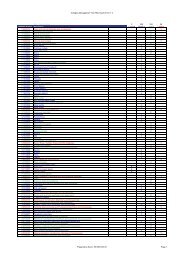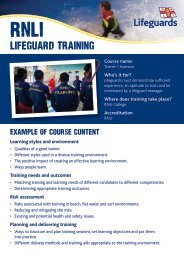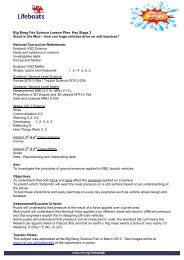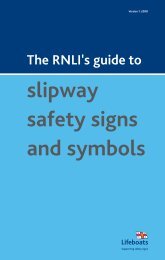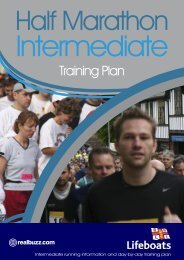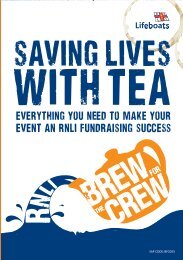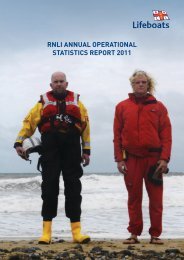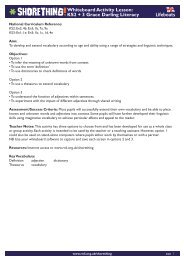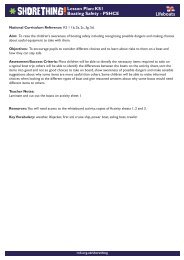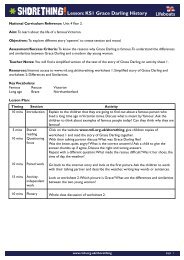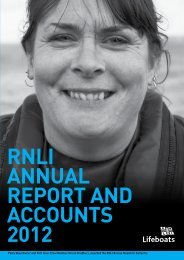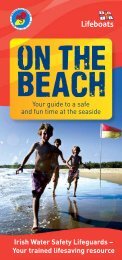Marathon
Marathon Advanced Training Plan - RNLI
Marathon Advanced Training Plan - RNLI
- No tags were found...
Create successful ePaper yourself
Turn your PDF publications into a flip-book with our unique Google optimized e-Paper software.
<strong>Marathon</strong>AdvancedTraining Planrealbuzz.comAdvanced running information and day-by-day training plan
<strong>Marathon</strong> AdvancedTraining PlanContentsIntroductionBefore you begin . . .Safety firstHealth-status safety checklistThe marathon1 Getting startedSpecialist gearShoesSocksShorts and tightsTopsGlovesHatsSports bras345Structuring your sessionsWarm-upMobilityMain sessionCool-downFlexibilityAdditional trainingFlexibility trainingCross-trainingResistance trainingAdvanced <strong>Marathon</strong>Training PlanProgramme notesTerminology16-week training planConclusions2 Principles of training 2realbuzz.com
<strong>Marathon</strong> AdvancedTraining PlanIntroductionBefore you begin . . .Congratulations, you’re running the marathon and looking to improve. From beginning your specificmarathon training, to lining up at the start and finishing; preparing for and running in the marathon is alwaysan experience that you will never forget. This advanced training plan focuses on everything you need to getstarted, sensible precautions to take, and it also contains a week-by-week structured programme that willconvert you into a fitter, healthier, successful marathon runner. However, before you don your trainers and startthat first training session, take a little time out to check a few safety considerations.Do you have the right training plan?It could be dangerous to follow the advanced training plan if you are really a beginner or intermediate runner.If the following applies to you, you have the correct plan. However, if your current level of running training isless than the following, you may need the beginner or intermediate plan.Current level of running trainingYou are already a runnerApproximate expectedfinishing time band2h 45m – 3h 15mYou have been running for a year or more.Your weekly long run is currently at least 15 miles.You have competed in 10k and half marathon events.You are currently comfortable with running approximately 40 milesper week.You have already completed a marathon and are looking toimprove your time.Introduction continued...realbuzz.com3
<strong>Marathon</strong> AdvancedTraining PlanSafety firstTo start with, it is vitally important to ensure that it is safe for you to begin an exercise programme. Completethe safety checklist below and if you answer YES to one or more questions, or alternatively, if you are at allconcerned about starting training, then make an appointment with your doctor for a check-up before youstart.Health-status safety checklist1 Are you aged over 30 and/or have not exercised for some time? Y/N2 Do you suffer from any medical conditions? Y/N3 Are you a smoker or have recently given up smoking? Y/N4 Have you undergone any surgery in the past two years? Y/N5 Are you suffering from any injuries? Y/N6 Are you currently on any prescribed medication? Y/N7 Are you unsure about beginning an exercise programme? Y/NOnce you have the all-clear from your doctor then you’re ready to step out on the road to marathon fitness.Introduction continued...realbuzz.com4
<strong>Marathon</strong> AdvancedTraining PlanThe marathonThe marathon is one of life’s great challenges – and open to all! Thelate Chris Brasher dubbed it ‘the great suburban Everest’ which is anextremely apt description. There are numerous marathon eventsthroughout the UK, from the world famous Flora London <strong>Marathon</strong>to smaller events such as those at Sheffield, Luton and even LochNess. Some are incredibly scenic such as the New Forest marathon,others offer fast, flat courses like Abingdon but each has it’s ownparticular atmosphere. Further afield, most international cities stagemarathons, with New York, Paris, Berlin, Chicago some of the big hitters. Whichever event you choose,stepping up to the challenge of training for and completing 26.2miles is an incredible experience no one ever forgets.Additionally, improving on a previous best time isextremely satisfying as you reap the fruits of your trainingthrough improved levels of fitness. Completing themarathon is a magnificent achievement wherever youfinish in the field and this training plan steps you throughto race day competitor and includes a multitude of tipsand advice to help you reach your marathon goal.realbuzz.com5
<strong>Marathon</strong> AdvancedTraining Plan1 Getting startedSpecialist gearYou’re already a runner and have experience of training and racing. You will already own many items of kitbut specific kit items can not only aid your training and racing comfort, they can also improve yourperformance. Your target is to knock time off your current marathon PB and choose the correct kit can helpyou run faster and more efficiently. The most important point is that you have suitable clothing (particularlyfootwear) and that you feel comfortable in everything. The most technical and most important kit you needto buy are your running shoes and to replace them regularly. You may want to consider racing shoes for theevent, which are lighter, stripped down versions of conventional trainers.ShoesCorrect footwear is one area where you should never compromise. Good running shoes are aninvestment in comfort, protection and injury prevention and it is worth visiting a specialist sports footwearretailer rather than a chain store and discussing your requirements with them. A specialist retailerwith gait analysis and pressure plate testing will be able to assess yourrequirements and recommend suitable shoes for your particular gaitand running style. If you decide on racing shoes, they usually haveless cushioning and motion control systems than standard trainers,so discuss your plans with your retailer. Racing shoes can be 50%lighter than training shoes and can make a big difference to yourrace times. Studies estimate that a time gain of up to 10 secondsper mile can be achieved with lightweight shoes, potentiallyknocking almost 4 ½ minutes off your PB.Getting started continued...realbuzz.com6
<strong>Marathon</strong> AdvancedTraining PlanSocksAdvanced, lightweight and foot-specific socks (left and right fitting socks) have a great benefit in thatthey hug the foot better and there is no excess sock floating around in the shoe which may causeblisters. Modern types have specially designed wicking areas to help keep your feet dryer, together withmore cushioning at the heel and forefoot. In addition to racing flats, specialist socks can furtherenhance your race day performance.Shorts and tightsAfter socks come shorts, or when it is colder, tights. Shorts should be comfortable, lightweight and havethe ability to wick away sweat when you train. Elastic-only shorts often move down a little, especially inwet conditions, so choose specific, lightweight shorts with both elastic and a draw-string waist.When the weather is colder it is advisable to wear tights to keep your legs warmer and thus reduce thechance of injury. Fabric technology has exploded recently with the aid of new synthetic materials andNASA technology. This has aided running no end with high tech materials filtering down to basic runningkit like tights and t-shirts. The running tights are available which hug the legs more efficiently and stop thewind and rain penetrating the leg itself. This helps in reducing injuries from cold muscles and also meansthat you can enjoy running when the weather is a little worse than ideal. Only diehard older runners nowwear loose fitting cotton tights.The fashionable and technological knowledgeable runners are choosing high tech garments that helpthem in their running. Your tights should be snug fitting and comfortable. It is important to try them onbefore you buy because many manufacturers have different cuts to suit different styles of runner.Generally the more expensive the tights, the more comfortable they will be and the betterat keeping you cool in summer and warm in winter.Getting started continued...realbuzz.com7
<strong>Marathon</strong> AdvancedTraining PlanTopsShort and long-sleeve t-shirts have also benefited, like tights, from technological advances. The midto top range t-shirts all wick away sweat to keep you cooler and allow a greater air circulation throughthe fabric. They feel very lightweight but have the properties to keep you warm or cool depending onwhen and how you wear them. Running t-shirts should be reasonably tight but not figure-hugging andlikewise they shouldn’t flap around when you run in them. It is a fine balance between well-fitted andslightly baggy that you should aim for. With long sleeve t-shirts, you should aim to get ones with cuffedsleeves so they stay down around your wrists. If there are no cuffs then the sleeves often ride up yourarms when you run and this can be both annoying and cold.Similarly, for hot weather training, modern vests are also designed with technological, wicking fabricsthat also help air circulate around your body to aid cooling.When the weather gets really cold or wet it is advisable to run in a gillet or a long-sleeve waterprooftop. These offer excellent wind-stopping and rain-resistance capabilities and can keep you warmand dry throughout any run. Gillets are sleeveless jackets and ideal for quicker running in slightlywarmer climates while full long-sleeve waterproofs are better for colder and wetter climates. Thegillets at the top end are very high tech and guaranteed waterproof and windproof. Cheaper versionswill be fine for most running conditions but they will sacrifice certain aspects like being 100%waterproof or windproof. Being prepared for cooler conditions enables you to stay warm, dry and enjoythe run more. In warmer climates the new fabrics and technologies enable you to train harder bystaying cooler and wicking away sweat and moisture from the body. Both of these mean you can’tblame the weather for not training anymore and you can get and stay fitter all year roundnow in comfort and style.Getting started continued...realbuzz.com8
<strong>Marathon</strong> AdvancedTraining PlanGlovesThese should be lightweight and comfortable. Only in extreme weatherwill you need to wear thick running gloves (which even in the UKshould be unlikely through the summer!) and more often thannot you will heat up enough to be okay in the normal thin type.Woollen gloves are the norm because they are cheap to buybut they don’t offer the same waterproof and wind stoppercapabilities of the new high tech fabrics. Woollen gloves will befine for most runners but if you are venturing out into colder or wetterclimates, it is worth investing in a high tech pair. Running with cold hands can ruin the experience foryou, so choose carefully when you buy, especially if it is near wintertime.HatsHats are similar to gloves in that woollen ones are the norm because they are easy to get hold ofand cheap. The more high tech versions such as fleece offer wind stopping capabilities and someare waterproof as well. Caps offer greater protection from the rain, snow and sun but often they canget blown off in windy conditions. They don’t offer the same warmth capabilities as woollen/high techfabrics but they are good when you need better protection from the elements. In addition, they arebetter for runners who wear glasses because they help the glasses from getting rain or snow on.Getting started continued...realbuzz.com9
<strong>Marathon</strong> AdvancedTraining PlanSports brasIt is important to wear a sports bra that fits you snugly and gives adequate support for running. Thebust is only held in place by the skin around it and the Coopers Ligaments and when the bust moves,these ligaments can stretch result in a permanent droop. In addition, this movement can be painfuland leads many women to avoid certain activities that could be enjoyed with a good sports bra!Everyone is different and you may well need to try on a few different products before finding what isjust right for you.So does your sports bra fit?Your bra should fit snugly under the bust without being uncomfortably tight.All of your bust should fit in the bra without any bulges around the sides.The shoulder straps should not dig in (for larger busts wider straps are more comfortable).When you run there should be significantly less bounce than with a normal braMost ladies should only need to wear one sports bra even for high impact activities.There are many excellent bras on the market, which come in a large range of sizes and coloursoffering every different level of support.realbuzz.com10
<strong>Marathon</strong> AdvancedTraining Plan3 Structuring your sessionsWhatever your experience, to get the most out of your training, you should adhere to the followingsequence each time you train:Warm-upThe warm-up, raises the heart-rate, gets blood flowing to the working muscles and prepares the body for exercise.It should be for a minimum of five minutes and replicate the movements or activities of the main session.For example: when beginning a run, 5-10 minutes very easy jogging will prime the body for the main trainingsession.MobilitySome basic actions to put the limbs through the range of movement that the main session requires will ensurethat the joints are loosened up, lubricated and will function more efficiently.Main sessionThis will form the bulk of the training session. For example: a brisk 5-mile run.Cool-downThe cool-down should be at a lower intensity than the main session and should bring the body temperature andheart rate closer to pre-exercise levels. Additionally, waste by-products of exercise will be flushed from the musclesand tissues, accelerating recovery before the next training session.For example: the cool-down should be a minimum of 5-10 minutes light CV. Jogging is ideal.FlexibilityStretching exercises should be carried out after the main session and cool-down as the body is in a greater stateof relaxation than at the beginning of the session. 5-10 minutes spent stretching the muscles worked will maintainsuppleness.realbuzz.com 12
<strong>Marathon</strong> AdvancedTraining Plan4 Additional trainingObviously running forms the core of all your training because you are training to condition your body tocomplete 26.2 miles as fast as possible. However, it is also beneficial to incorporate other types of training inyour programme, so that you toe the start line in the best possible shape.Flexibility trainingThere are a multitude of flexibility exercises for stretching every muscle in the body. Primarily, you need tofocus on leg stretches to keep your muscles long, supple and injury free. See the realbuzz.com guide:‘Exercises and stretches – The no-nonsense guide’ for specific examples of flexibility training. The key is toensure that the muscles that have been utilised during your workout are stretched at the end of the trainingsession.For example: at the end of your run and cool-down, spend a few minutes stretching the hamstrings, quadriceps,calves and adductors.Cross-trainingCross-training is the name given to other forms of training that complement your running training. Crosstrainingcan be extremely beneficial because it allows your body to recover from a run whilst still providingtraining benefits. Running is a very repetitive activity that if not carried out correctly, can lead to overuseinjuries. By occasionally adding different activities to your programme, you keep fresh and significantlyreduce any injury risk.For example: the day after a long endurance training run, a light swimming session or bike ride will stillprovide cardiovascular benefits but without the same loading on muscles that have been fatigued fromrunning.realbuzz.comAdditional training continued...13
<strong>Marathon</strong> AdvancedTraining PlanResistance trainingResistance training is extremely beneficial to complement your running; strengthening all around the bodyand correcting any muscle imbalances. The range of resistance training exercises for training specificmuscles is immense, (see the realbuzz.com guide: ‘Exercises and stretches – The no-nonsense guide’) andcan enhance your running performance through improved posture and all-round strength.Resistance exercises should be carried out on non-running days to avoid over fatigue and also so that thequality of your running training is not compromised.For more information on suitable supplementary resistance training, see the realbuzz.com training plan‘Muscle up!’ for a comprehensive resistance training programme.realbuzz.com 14
<strong>Marathon</strong> AdvancedTraining Plan5Advanced <strong>Marathon</strong> 16-weekTraining PlanPlan notesThis programme is a day-by-day 16-week schedule. The plan assumes:You are a regular runner.You have been running for a year or more.Your weekly long run is currently at least 15 miles.You have competed in 10k and half marathon events.You are currently comfortable with running approximately 40 miles per week.You have already completed a marathon and are looking to improve your time.For each session in the plan, follow the protocols for warm-up, mobility, main session, cool-down and flexibilityoutlined earlier. Start at week one but if your training is slightly ahead, you can jump in at a later week.Simply check the week-by-week chart to see which week matches your current activity levels and then startat that point.There is flexibility within the programme for switching training sessions around during the week to fit in withyour other commitments such as work, home, family etc. The key point is to ensure that your training is balancedeach week, including flexibility, CV and rest.Advanced marathon training continued...realbuzz.com 15
<strong>Marathon</strong> AdvancedTraining Planrealbuzz.comDon’t be a slave to the programme! The training programme is designed with rest days, recoverysessions and lower volume weeks. This will ensure your body has time to adapt to the training. However,every runner is different and if you feel that an extra days rest will be beneficial to your training, simplytake out one of the shorter sessions in that week.If you find it difficult to complete some weeks due to lack of time, always try to complete the long run andquality sessions. The most important factor with training for the marathon is to build endurance, followed byspeed endurance, so try to complete all the long runs and interval/fartlek/hill sessions.Avoid over-reaching and extending all your training runs in an attempt to improve faster. If you wish to runmore miles, choose the optional extra morning/lunchtime runs described for each week but keep them easyand relaxed.TerminologyThe programme will frequently refer to the term ‘fartlek’. Fartlek is a Swedish word that means speed-play. Afartlek session is an unstructured, quality training session, where instead of running at a uniform pace, you varythe pace throughout the run, depending on how you feel. For example, a 7-mile fartlek session could be:Warm-up for 1 mileRun hard for 1 mileEasy jog recovery for ½ mileSteady running for 1 mileRace pace for 2 miles1 mile cool-downAlternately sprint and jog for ½ mileThe key thing with a fartlek session is that you simply run as you feel, backing off when you start to tire,speeding up if and when you want to and for as long as you like.realbuzz.com Advanced marathon training continued... 16
<strong>Marathon</strong> AdvancedTraining Plan16-week Training PlanWeek 1 The startDay Training Training notes MileageOptional 2 early morning runs totalling 10 miles 0-10Mon 6 miles steady 6Tues 3 x 1 mile (2 mins recovery between miles), Programme will typically contain two 5+ warm-up and cool-down. quality sessions per week.Wed Resistance training session All-over body programme, including core.Thurs 5 miles easy Recovery from Tues and Wed. 5Fri 6 x 800m (1 minute recovery) + good 5warm-up and cool-downSat 5 miles brisk 5Sun 17 miles taken very easily 17Total weekly mileage 43-53Week 2 First raceDay Training Training notes MileageOptional 2 early morning runs totalling 10 miles 0-10Mon Easy 5 miles 5Tues 2 x 2 miles (4 minutes recovery) + warm-up 6and cool-downWed Resistance training as per week 1Thurs Steady 6-7 6-7Fri 8 miles hilly fartlek 8Sat 5 miles easy 5Sun 10K race + good warm-up and cool-down Maximum effort, record time. 9Total weekly mileage 39-50realbuzz.comAdvanced marathon training continued...17
<strong>Marathon</strong> AdvancedTraining PlanWeek 3 Building long runsDay Training Training notes MileageOptional 2 early morning runs totalling 10 miles 0-10Mon 6 miles, starting slowly 6Tues Mile repetition session as per week 1 Look to improve times. 5Wed 10 miles steady 10ThursResistance training sessionFri 6 x 800m (1 minute recovery) + good 5warm-up and cool-downSatRestSun 18 miles steady Start easily. 18Total weekly mileage 44-54Week 4 Endurance race weekDay Training Training notes MileageOptional 2 early morning runs totalling 10 miles 0-10Mon 5 miles recovery run 5Tues 8 x 1,000m (2 mins recovery between each) 7+ warm-up and cool-down.WedResistance training sessionThurs 10 miles steady, off-road if possible. 10Fri 6 x 1 mins with equal distance jog recoveries, 5+ warm-up and cool-down.Sat3 miles easy jogSun ½ marathon race or equivalent time-trial, Full effort, record time. 15+ warm-up and cool-downTotal weekly mileage 42-52realbuzz.com Advanced marathon training continued... 18
<strong>Marathon</strong> AdvancedTraining PlanWeek 5 Long run hits 20 milesDay Training Training notes MileageOptional 2 early morning runs totalling 10 miles 0-10Mon Easy swimming or cycling for 35 mins. Try and get a massage if possible.Tues Steady 6 miles 6WedResistance training + easy 3-mile jogafterwards 3Thurs 10 miles even pace run Slower than marathon pace. 10Fri4 x 1 mile (2 minute recoveries) + warm-upand cool-down 6Sat 4 miles easy 4Sun 20 miles steady pace Start easily. 20Total weekly mileage 49-59Week 6Day Training Training notes MileageOptional 2 early morning runs totalling 10 miles 0-10MonRestTues Hill session. 8 x long hill repetitions (3 mins 6each approx) + warm-up and cool-downWed Steady 6 miles 6Thurs Off-road fartlek Go as you please. 9Fri 6 x 1 minute with equal distance jog 5`recoveries, + warm-up and cool-downSat 5 miles easy 5Sun 10 mile time-trial + warm-up and cool-down 12Total weekly mileage 43-53realbuzz.com Advanced marathon training continued... 19
<strong>Marathon</strong> AdvancedTraining PlanWeek 7Day Training Training notes MileageOptional 2 early morning runs totalling 10 miles 0-10Mon Steady 6 miles 6Tues3 x 2 miles (3 minutes recovery) + warm-upand cool-down 8Wed 4 miles relaxed run 4ThursResistance training sessionFri Brisk 8 miles 8SatRestSun 21 miles slow 21Total weekly mileage 47-57Week 8 Mini taper & half marathon raceDay Training Training notes MileageMon 4 miles easy jog, ideally off-road 4Tues 7 miles fartlek 7WedResistance training sessionThurs 6 miles steady 6FriRestSat 2 miles easy jog 2Sun ½ marathon race + warm-up and Look to beat week 4 time. 15cool-downTotal weekly mileage 34Advanced marathon training continued...realbuzz.com 20
<strong>Marathon</strong> AdvancedTraining PlanWeek 9 Building up againDay Training Training notes MileageOptional 3 easy early morning or lunchtime runs 0-15totalling 15 milesMonTuesEasy swim or cycle for 30 minutesResistance training sessionWed 4 x 1 mile (2 minute recoveries) + warm-up 6and cool-downThurs 10 miles steady pace 10Fri8 miles fartlek with 3 minute effortsthroughout 8Sat 5 miles light 5Sun 22 miles steady pace 22Total weekly mileage 51-66Week 10Day Training Training notes MileageOptional 3 easy early morning or lunchtime runstotalling 15 miles 0-15Mon 5 miles easy 5Tues 8 x 800 metres (1 minute recoveries) + 6warm-up and cool-downWed 12 miles steady Ideally off-road. 12ThursResistance training sessionFri 8 x 1 minute with equal distance jog 6recoveries, + warm-up and cool-downSat 5 miles easy 5Sun 15-mile fast pace run Run as a time-trial 15Total weekly mileage 49-64Advanced marathon training continued...realbuzz.com 21
<strong>Marathon</strong> AdvancedTraining PlanWeek 11Day Training Training notes MileageOptional 3 easy early morning or lunchtime runs 0-15totalling 15 milesMon 6 miles relaxed, ideally off-road 6Tues 10 miles, including 8 x 2 minute hill efforts 10WedResistance training sessionThurs Steady 6 miles 6Fri 7 miles starting slowly, building to ½ 7marathon race pace.SatRestSun 24 miles easy pace Start slowly 24Total weekly mileage 53-68Week 12 Mini taper and 10k raceDay Training Training notes MileageOptional 2 easy early morning or lunchtime runstotalling 10 miles 0-10Mon 5 miles easy off-road run 5Tues 4 x 1 mile ( 2 minute recoveries) +warm-up and cool-down 6Wed 14 miles steady run 14ThursResistance training sessionFri 6 miles fartlek 6Sat Easy 4 miles jog 4Sun 10K race + good warm-up and cool down Look to improve on week 2 time. 9Total weekly mileage 44-54realbuzz.com Advanced marathon training continued... 22
<strong>Marathon</strong> AdvancedTraining PlanWeek 13 Peak mileage weekDay Training Training notes MileageOptional 3 easy early morning or lunchtime runs 0-15totalling 15 milesMon Steady 6 miles 6Tues 5 x 1 mile (2 minute recoveries) + 7warm-up and cool-downWedResistance training sessionThurs 12 miles steady run 12Fri 8 x 1 minute with equal distance jog 6recoveries, + warm-up and cool-down.SatRestSun 24 miles at close to marathon pace Last long run 24Total weekly mileage 55-70Week 14 Start of race taperDay Training Training notes MileageOptionalMon2 easy early morning or lunchtime runstotalling 10 miles 0-10Swim or cycle for 30 minutesTues 8 miles including 8 x 3 minutes fast 8Wed Steady 8 miles at marathon pace 8Thurs Resistance training session Last gym workoutFri Rest or easy 3 mile jog 0-3Sat 4 miles easy jog 4Sun15 miles steady, slightly slower thanmarathon pace 15Total weekly mileage 35-48realbuzz.com Advanced marathon training continued... 23
<strong>Marathon</strong> AdvancedTraining PlanWeek 15 Further taperingDay Training Training notes MileageOptional1 easy early morning or lunchtime runstotalling 5 miles 0-5Mon 5 miles easy off-road 5Tues 6 miles easy with 5 x 1 minute bursts 6Wed 7 miles brisk pace Not flat out 7Thurs 4 x 1 minute with equal distance jog Not flat out 4recoveries, + warm-up and cool-down.FriRestSat 2 miles easy jog 2Sun 10 miles slower than marathon race pace Wear race kit and shoes 10Total weekly mileage 34-39Week 16 Final taper and preparation weekDay Training Training notes MileageMon Rest Try to get a leg massage early this week.Tues1 mile warm-up, 1 mile at marathonpace, 1 mile cool down 3Wed Steady 4 4Thurs Easy 4 miles with 6 x 20 second bursts 4FriRestSat 2 miles easy jog 2Sun Race Day! THE RACE! 26.2 milesTotal weekly mileage 39.2realbuzz.com24
<strong>Marathon</strong> AdvancedTraining PlanConclusionWell done!You have come to the end of the 16-week schedule, and your speed, strength, endurance and speedendurance has advanced. You should be feeling considerably fitter and feel yourself moving up. Alongthe way, you have made significant health and fitness gains, and equally importantly, you have progressedsafely. As well as your race goals, by maintaining your training, you will be making a major contributionto your long-term health and fitness and this advanced schedule can also serve as a foundationand springboard to increase your fitness levels further.Statistics show that most runners can continue to improve and progress for at least seven years after theyfirst take up the sport. Now you’ve advanced and have improved, after a race recovery period, evaluateyour training and racing strengths and weaknesses before you launch into your next racing challenge.That way you can map out a structured plan that could see you advance further in your next competition.DisclaimerNeither realbuzz.com or its associated companies can accept any responsibility for death or injuriescaused by any information contained within. All information is provided in good faith. You should consultyour doctor before embarking on any programme of physical activity.By using this information you agree to indemnify, defend, and hold us harmless from and against anyclaims, actions, demands or other proceedings brought against us by a third party, to the extent that suchclaim, suit, action or other proceeding brought against us is based on or arises in connection with youruse of the pack, any breach by you of these terms and conditions or a claim that your use of the packinfringes any intellectual property rights of any third party or is libellous or defamatory, or otherwiseresults in injury or damage to any third party.realbuzz.com25



